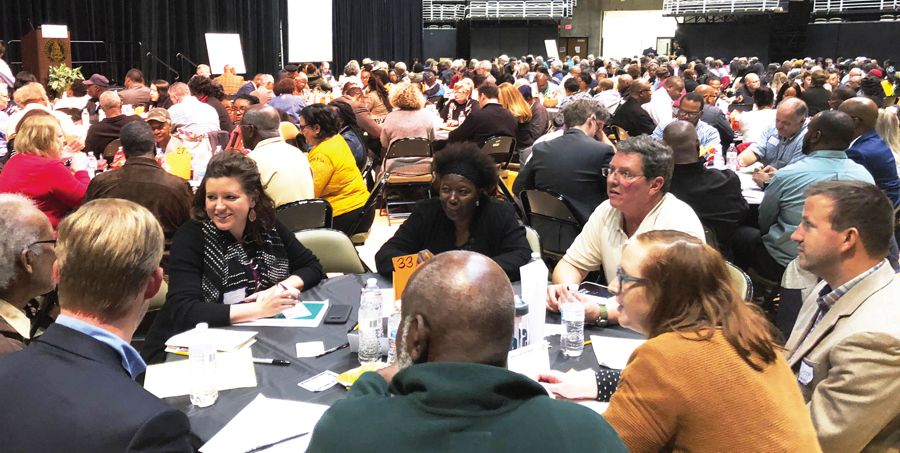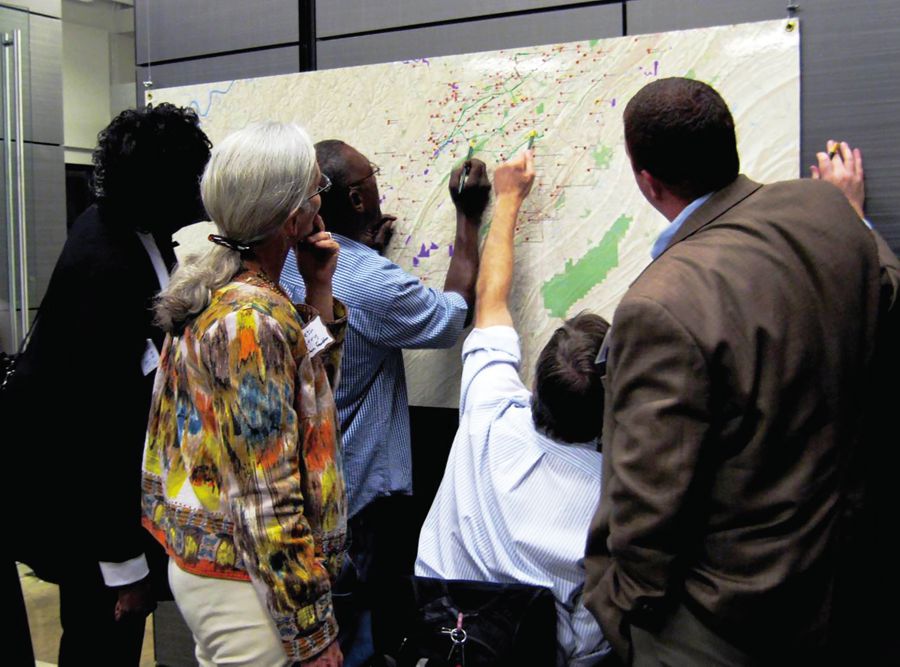Insights into Community Master Planning
Civic leaders look to decisively develop community master plans to best serve their residents. The old adage that says "people don't plan to fail, they fail to plan" rings true in community planning, where the goal is to understand the current state of the community's and set goals and expectations for where it will go in the future. While some states have planning requirements that serve as guidelines for communities, those places with no mandate should make a plan as well to improve the community aesthetics and how it serves residents. Communities have limited resources and financial constraints, and plans provide the needed justification to make changes. Community plans can help define the expectations of the community for its leaders. This is no small task, nor is it simple.
To optimize community master planning, leaders face challenges to effectively communicate with residents to solicit feedback about their needs and desires. Such feedback is vital. The information gathered helps both leaders and project teams understand and develop the community vision and its intent, which is translated into a master plan to support project execution. At the heart of this is articulating the vision in a way that reflects the community's priorities.
Challenges
>> Understanding local culture, defining communication: One of the key challenges for stakeholders as well as project teams serving the community is to quickly get the pulse of the local culture, understanding the community—elected officials, businesses and other decision-makers—and coordinating how to communicate and work effectively within their sphere.
Local leaders and project teams may approach a new project with great ideas that have been successful in the past, but every new initiative is different, and a one-size-fits-all approach does not exist. Teams approaching a new project need to communicate effectively with local stakeholders to identify and define the underlying drivers within community intent.
>> Negotiating perspectives toward effective execution: In many cases, the team is working in close connection with the local government, whose participation is part of protocol. Project team leaders seek to guide the public interest in the project, negotiating the difference in perspective between leaders, project managers and members of the public.
One of the most difficult challenges in this area is the actual conversations with the community. Because they set the vision and intent, these conversations are critical, so it is important to plan well and execute effectively. Much of the efforts in community planning are forward-looking, but ample research on the current state provides a snapshot of what the community is like currently. To establish a baseline from the status quo, the team sits down to a discussion with members of the community after outlaying project purpose and intent, to understand current demographics.
The discussion also focuses on current amenities—parks and recreation, education, and community facilities and services—all the things that define their quality of life. This is a critical step because planners and residents need a solid understanding of where the community is currently before they can craft recommendations or determine their vision.
Understanding the Community Vision & Intent
>> Capturing community outlook: Capturing the community outlook as a project begins can take several weeks. An open, public discussion is a key element to capturing that community outlook. This could be a community workshop, a charette, town hall meeting or any other opportunity to come face-to-face with the community. A website with information and the opportunity for the public to offer feedback can supplement the information gathered in person.
To generate interest in a public discussion, leaders seek to communicate the most engaging aspects of the project, highlighting the most urgent. Information gathering is also an ongoing multi-step process. In some communities, project teams have leveraged the influence of faith-based organizations or inserted flyers in local water bills to help spread the word across the wider population. When planning lasts eight to 12 months, project teams engage with people at different points along the timeline, and public opinion may shift, or more voices join the conversation as the planning progresses toward the goal.
>> Active, interpersonal engagement creates momentum: When meeting with the public, active, interpersonal approaches are optimal. For instance, in a community meeting, creating scenarios that engage people with one another is better than a speaker/audience format. Savvy community building experts guide initiatives to success in forming groups of eight to 10 people and offering them a series of questions to consider. People often feel more comfortable and open talking with their neighbors than local leaders, so the results are typically more interesting.
Leading questions include asking them what they value, what they feel is important in their community at present, and what they'd like to see in the future. These open-ended, constructive, forward-thinking questions generate productive discussions toward establishing goals. Once the goals are clear, local officials and project team leaders guide the community to make those goals a reality. Project managers and community participants visualize success together to create momentum for the future.
>> Master planning illuminates priorities: When projects are part of a community master plan, it is easier to see where they fit on the continuum of priorities and execution. For example, a five-year master plan for a city in Alabama was working on a council district basis. The mayor was able to charge each of five local council members to assemble their constituents for five smaller meetings, rather than one large public forum. To make the small-group meetings successful, it was important for council members and the project team to ask the right questions to generate a productive discussion without getting too granular.
Savvy community experts have insight into what information is needed to achieve success, and can help guide the discussion based on what they know about the community through detailed, specific demographic and land-use analysis. The local council members provide input on the current issues and major concerns in the community, so those are sure to be addressed.

>> Small, successful steps lead to momentum for the future: With these communication strategies, the project team gathers all the information they need for effective project execution while also ensuring that the voice of the community is present, enabling them to take ownership of the planning.
Starting small is effective from a communications perspective, but also in building momentum. Demonstrated success on small projects, or smaller components of a large project, helps to make the case for bigger projects and shows the community that leadership can generate the momentum needed to build for the future.
Insights for Planning & Execution
>> Clear, succinct, readable plans: Part of the success of contemporary community plans is their relative simplicity. With less jargon and more straightforward, accessible language, anyone can understand them. An emphasis on leaner page counts means that people are more likely to actually read the plan and take it all in.
A certain level of detail is required for large-scale plans, but if the presentation is succinct, with a targeted focus, it is possible to communicate the details clearly. Starting with broad goals rather than a series of steps, the city can circumvent many procedural reports that become self-explanatory when the goals are reiterated. Less extraneous detail helps communities move forward with implementation of their plans at a quicker pace, substantially increasing efficiency of planning and execution for future projects.
>> Community-based plans: Planning is about providing a flexible framework and a series of goals and policies for the community, paving the way for future decision-making. In the past, such planning efforts would have resulted in a "to-do" list with dictated tasks. Today, local governments are leaner and more flexible, which allows plans to transcend leaderships becoming effectively community plans, rather than administrative edicts.
>> Community-driven priorities: In recent years, many communities have had a reduction in resources that has required them to be more efficient and flexible. Along with a leaner approach to operations, communities have learned the art of prioritizing for master plans and individual projects. With input from residents, communities determine what is most important and look for opportunities to deliver on targeted needs.
Every community is different, so project leaders and planners have to understand how the community operates in order to set appropriate priorities. For example, the loudest constituency is not always the majority; not all supporters are vocal, but it doesn't mean they don't exist. Often, the loudest voices are the ones in opposition to a project, so it is crucial to be prepared for those groups, understand their point of view and plan a strategic approach for working with them.
>> Transparency and integrated communication: Communication is a two-way street, and keeping transparent discussions going makes the community feel included. If residents feel their voices are being heard, they will be more open to accepting the unpopular decisions when necessary. Planners have expertise in active listening to capture feedback and ensure that all sides are adequately represented. That underscores the vital importance of getting a pulse on the local community and what drives their opinions and decisions.
>> Creating a large-scale plan: An example project in Mobile, Ala., exemplified learning a new approach to creating a large-scale plan influenced by the public voice. Mobile had seen many smaller-scale plans in recent history, but it had been 50 years since they had conducted a sweeping, city-wide community plan.
Not only had demographics and public opinion naturally shifted in that time, the planning process had become more complex—but also more effective. The project benefited from a strong planning team that guided conversations to gather public input. The result was a comprehensive plan that provided general principal goal structure without being overly extensive. The plan has proven effective for the community, and the decisions they make today are grounded in that plan.
>> Navigating difficult decisions: A plan that espouses the viewpoints of the community is useful as a guiding principle when difficult decisions are required. Sometimes, decisions that are unpopular in the short-term contribute to a longer-term vision. For example, if the ultimate goal is for a community to be walkable, near-term changes regarding land use, street design and parking are necessary. While this may mean changing what the community is familiar and comfortable with, presenting the decision as a step in the direction of the defined community goal will encourage local support from within the community.
Ultimately, using effective communication endows a community with ownership of their master plan. Collaborating with the expertise of proven community planners to develop a plan that is decisive, lean and accessible to all residents results in projects that meet the defined needs of residents and enhance the community for everyone who lives, works and plays within it—all of which is no small task. RM



